Latest Trends in Customer Experience Management for 2025
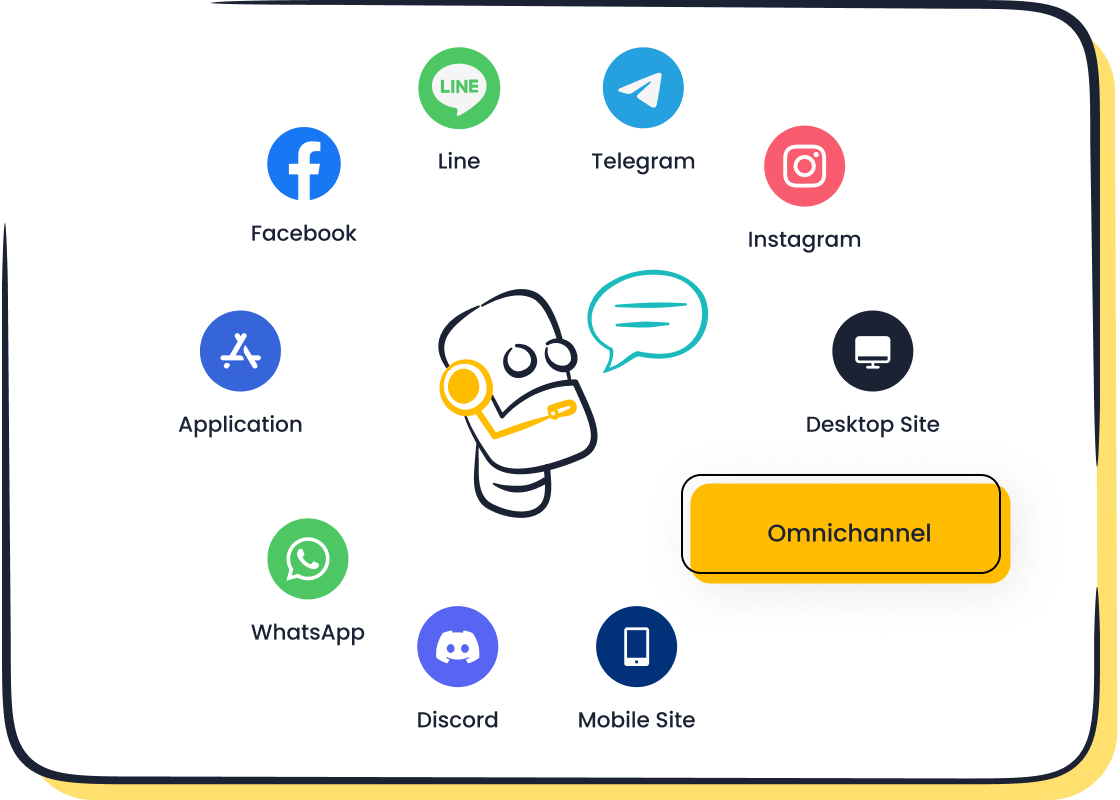
Businesses face a competitive landscape where the importance of customer experience management continues to grow. Companies that invest in emerging technologies and align with new cx trends see measurable gains.
| Statistic Description | Numerical Value / Insight |
|---|---|
| Additional revenue for $1B companies investing in CX | $700 million within 3 years |
| Buyers willing to pay more for great CX | 86% |
| Organizations citing CX as a competitive differentiator | 81% |
| Customers switching after one poor experience | Over 50% |
Sobot AI helps brands harness these opportunities by delivering omnichannel support and AI-driven personalization. Sobot empowers organizations to adapt quickly, using automation and data to create seamless customer journeys. Leaders should assess their current cx practices and readiness for digital transformation to stay ahead.
Importance of Customer Experience Management
Business Impact
The importance of customer experience management shapes business outcomes across every industry. Companies that prioritize cx see measurable improvements in revenue, retention, and brand loyalty. For example, Bain & Company found that businesses with high Net Promoter Scores (NPS) achieve nearly double the revenue growth and 20% lower attrition rates compared to their peers. Harvard Business Review reports that customers who receive the best experiences spend 140% more, while improving customer satisfaction scores helps retain 74% more customers for an extra year.
| Metric Category | Example Metrics / Cases | Business Impact |
|---|---|---|
| Financial Metrics | Revenue Growth, Customer Retention, CLV | High NPS: ~2× revenue growth, 20% lower attrition. Best CX: 140% higher spend. |
| Operational Metrics | First Contact Resolution, Average Handle Time | 1% FCR increase: 1% cost reduction, 1% CSAT increase. High CSAT: 20% lower costs, 15% more revenue. |
| Loyalty & Brand | NPS, CSAT, CES | High NPS: higher brand equity, lower churn, organic growth. Loyal customers spend more, refer more. |
| Case Study: Retail | Taylor & Hart | Focus on NPS doubled revenue, increased referrals. |
| Case Study: Telecom | Cox Communications | Improved NPS by 11 points, reduced churn, increased lifetime value. |
Sobot’s AI-powered solutions help brands achieve these results by automating support, improving first contact resolution, and providing actionable insights. Companies using Sobot’s omnichannel platform can unify customer data, streamline workflows, and deliver consistent service, which directly impacts financial and operational metrics.
Companies that measure and act on cx metrics experience a 20% increase in customer satisfaction and 15% revenue growth (Forrester).
Customer Expectations
Customer expectations continue to evolve rapidly. Today’s consumers demand fast, personalized, and seamless service across every channel. Research shows that 45% of people expect their issues resolved in the first interaction. Nearly half want responses within four hours, and 12% expect replies in just 15 minutes. Speed, availability, and expertise matter most, with 63% prioritizing quick responses and 49% valuing knowledgeable support.
- 80% of customers consider the overall experience as important as the product itself.
- 68% of millennials prefer self-service for general issues, highlighting the shift toward digital support.
- 99% of customers feel more comfortable when human assistance is available alongside AI.
- Positive experiences drive loyalty: 88% are likely to repurchase after good service, and 50% will pay more for better support.
Sobot addresses these rising customer expectations by offering 24/7 AI chatbots, multilingual support, and seamless integration across channels. The platform empowers businesses to meet the importance of customer experience management by delivering fast, accurate, and personalized service. As customer expectations rise, companies that invest in advanced cx solutions like Sobot position themselves for long-term success.
Customer Experience Trends 2025
AI and Automation
Customer experience trends for 2025 show a rapid shift toward ai-powered support and automated personalized services. Businesses across industries now rely on emerging technologies to meet rising customer expectations. According to Gartner, by 2025, 80% of customer service and support organizations will use generative AI to improve agent productivity and customer experience. Early adopters have already seen 10% to 20% productivity gains and up to 80% time savings in case summaries. These trends help companies respond faster and more accurately to customer needs.
| Statistic / Prediction | Description |
|---|---|
| 96% consumer trust increase | 96% of consumers trust brands more when business is easy and seamless. |
| 1% shareholder value increase | A one-point rise in customer satisfaction can boost shareholder value by 1%. |
| 80% generative AI adoption (2025) | 80% of service organizations will use generative AI by 2025. |
| 10-20% productivity increase | Early adopters see 10% to 20% productivity gains in customer service. |
| 20-30% agent replacement (2026) | By 2026, 20% to 30% of service agents will be replaced by generative AI. |
Companies like KLM Royal Dutch Airlines and Camping World have implemented AI chatbots and voice agents, leading to faster response times, reduced ticket volumes, and higher customer satisfaction. These examples confirm that automated personalized services are not just a trend but a necessity for modern cx.
Sobot Chatbot Solutions
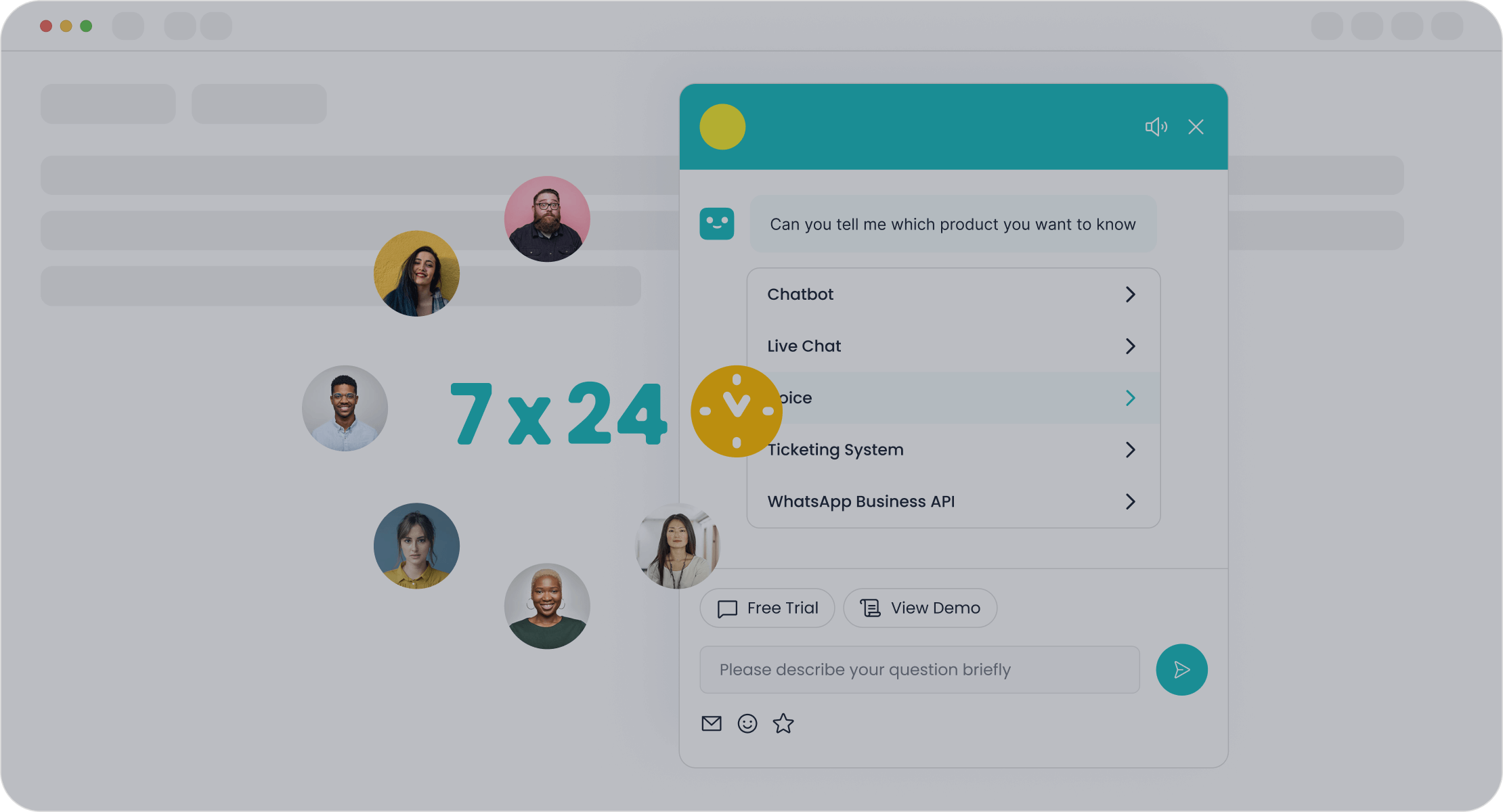
Sobot stands out as a leader in ai-powered support and automation. Its chatbot delivers automated personalized services across multiple channels, including WhatsApp and SMS. Sobot’s chatbot operates 24/7, handles routine queries, and assists human agents, improving productivity by up to 70%. Businesses using Sobot report up to 50% cost savings and a 20% boost in conversions.
Sobot’s chatbot is multilingual and easy to set up, requiring no coding. It uses a knowledge base built from articles, PDFs, and text, ensuring accurate and instant replies. For example, OPPO partnered with Sobot to manage high inquiry volumes during peak periods. The result was an 83% chatbot resolution rate and a 94% positive feedback rate, showing the real impact of these customer experience trends. Sobot’s solutions help brands deliver seamless, automated personalized services that drive loyalty and growth. Learn more about Sobot’s chatbot at Sobot Chatbot.
Digital Customer Experience

Omnichannel Integration
Omnichannel integration stands at the core of a successful digital customer experience. Companies now recognize that customers expect seamless transitions between channels, whether they start a conversation on social media, continue it via email, or finish it on a website. This approach helps brands deliver consistent service and messaging at every touchpoint.
- 89% of businesses will compete mainly on cx by 2025, surpassing product and price as key differentiators.
- Omnichannel engagement increases purchase and engagement rates by 250% and boosts retention rates by 90%.
- 40% of customer service organizations plan to adopt proactive strategies, shifting cx from a cost center to a profit center.
Performance metrics for omnichannel strategies include Customer Lifetime Value (CLV), engagement scores, loyalty scores, and Net Promoter Score (NPS). Companies also track engagement across channels, conversion rates, and operational efficiency. Sobot’s all-in-one contact center platform unifies data from chat, voice, email, and social media, enabling brands to map customer journeys and optimize every interaction. This unified approach ensures that customers receive fast, accurate, and personalized experiences, no matter where they engage.
Tip: Brands that integrate data from all channels gain a holistic view of their customers, leading to smarter decisions and higher satisfaction.
Personalization at Scale
Personalization at scale transforms the digital customer experience by making every interaction relevant and timely. Customers now expect brands to recognize their preferences, purchase history, and needs. Up to 80% of customers are more likely to buy when offered personalized experiences. AI-powered personalization leads to a 25% average increase in marketing ROI and can reduce customer churn by 28%. Companies using these techniques report double the engagement rates and up to 20% higher sales.
Sobot leverages AI to deliver hyper-personalized experiences across all channels. Its chatbot and AI solutions recommend products, answer questions, and provide support based on real-time customer data. This approach not only increases satisfaction but also drives loyalty and repeat purchases. For example, Sobot’s clients see conversion rates rise by 1.7× and customer satisfaction scores improve by up to 30%. Personalization at scale is no longer optional—it is essential for brands aiming to lead in cx.
Omnichannel Customer Journeys
Seamless Channel Switching
Modern customers expect to move between channels without losing context or repeating information. Omnichannel customer journeys make this possible by connecting digital and human interactions. When a customer starts a chat online and then calls support, the agent should already know the issue. This seamless handoff saves time and reduces frustration. In fact, 93% of customers report high satisfaction when they can switch channels smoothly. Companies see a 27% reduction in time spent on assisted channels and save an average of four minutes per customer journey. These improvements lead to higher loyalty and more efficient service.
| Metric / Data Point | Value / Impact |
|---|---|
| Customer satisfaction (CSAT) with seamless transitions | 93% high satisfaction |
| Reduction in time spent in assisted channels | 27% less time |
| Average rep time saved per customer journey | 4 minutes |
| Customers likely to return to self-service after easy transition | 74% |
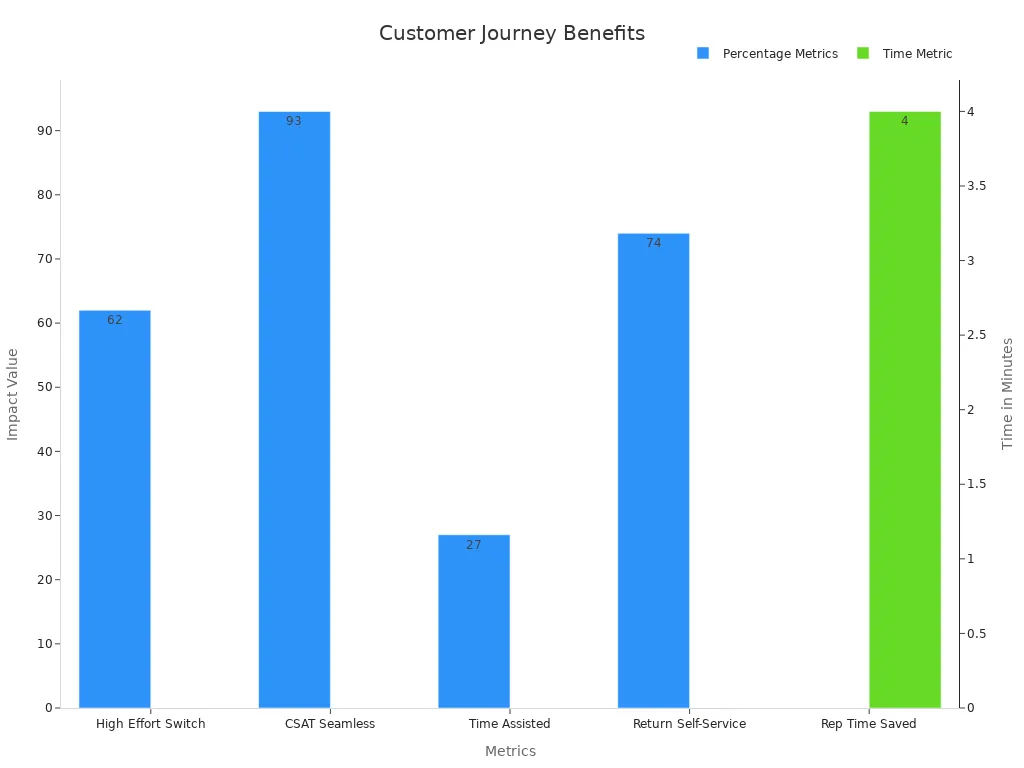
Sobot’s platform supports seamless channel switching by unifying chat, voice, email, and social media. This ensures connected journeys and consistent cx, helping brands deliver the experiences customers expect.
Unified Data and Insights
Unified data is the backbone of effective omnichannel customer journeys. Without a single view of customer interactions, companies struggle to understand needs and behaviors. A unified platform integrates all channels, providing complete customer insights. This approach helps businesses map the customer journey, identify friction points, and optimize engagement strategies. Analytics can predict churn, forecast satisfaction scores, and reveal upsell opportunities. For example, 89% of companies with unified cx retain more customers, and omnichannel shoppers spend 10% more online and 4% more in-store.
| Metric / Insight | Numerical Value | Business Impact / Benefit |
|---|---|---|
| Customer retention with unified CX | 89% retention rate | Improved customer loyalty and retention |
| Omnichannel customers spending more online | 10% more | Increased online sales from omnichannel shoppers |
| Omnichannel customers spending more in-store | 4% more | Increased in-store sales from omnichannel shoppers |
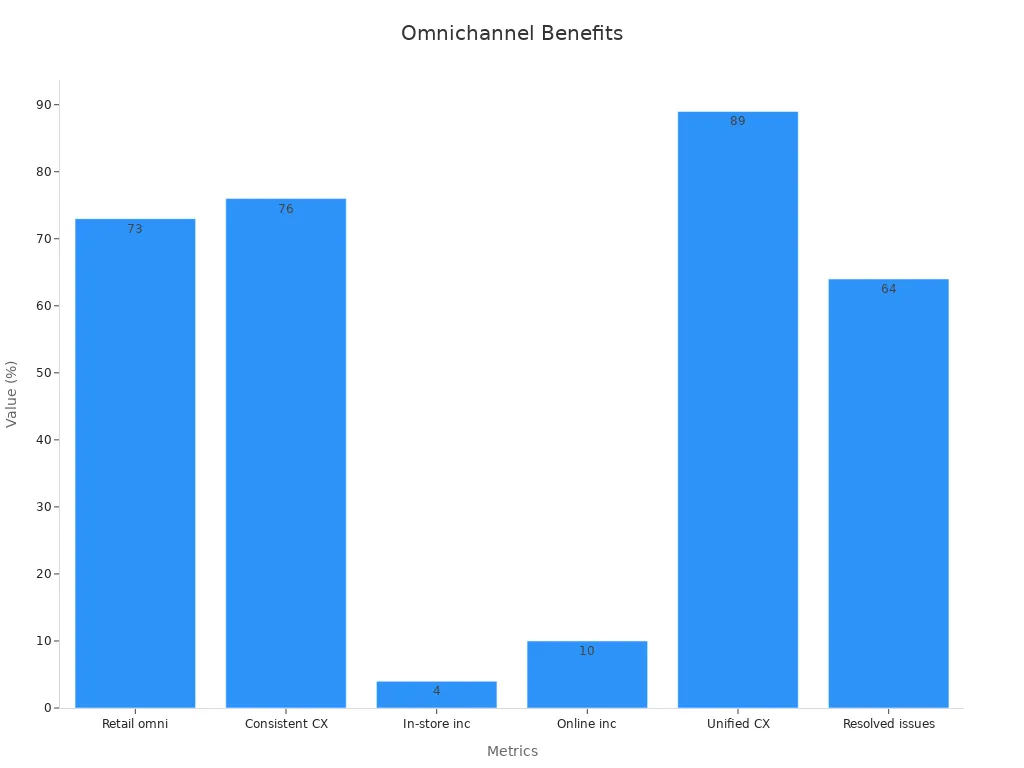
Sobot’s all-in-one contact center provides data-driven insights by analyzing every interaction across channels. This empowers teams to create targeted campaigns and improve service. Unified customer insights drive smarter decisions and better business outcomes.
Omnichannel Personalization
Real-Time Engagement
Omnichannel personalization gives brands the power to connect with customers instantly across every channel. Companies use real-time engagement to deliver personalized communication, offers, and support based on live data. This approach helps customers feel valued and understood. Businesses track metrics like Net Promoter Score (NPS), Customer Effort Score (CES), ticket volumes, and real-time feedback to measure the impact of these interactions. Platforms that unify data from chat, email, voice, and social media allow teams to see the full customer journey and respond quickly.
- Real-time personalization uses AI and machine learning to process data in milliseconds.
- Companies can adjust recommendations, promotions, and support instantly.
- Customers receive relevant information and help, which increases satisfaction and customer retention.
Note: Real-time engagement leads to higher customer loyalty because customers get what they need, when they need it.
Sobot AI Use Cases
Sobot’s AI solution helps brands deliver personalized solutions and hyper-personalized experiences at scale. For example, OPPO, a global smart device leader, used Sobot’s chatbot and ticketing system to manage high inquiry volumes. The system provided seamless, integrated customer service across channels. OPPO achieved an 83% chatbot resolution rate and a 94% positive feedback rate. Their repurchase rate increased by 57%, showing the power of omnichannel personalization in driving customer loyalty.
Research shows that:
- Omnichannel strategies improve customer satisfaction by offering convenience and consistency.
- Personalized communication and tailored offers increase customer loyalty and repeat purchases.
- Integrated customer service across channels boosts perceived value and enjoyment.
Sobot’s platform enables brands to deliver consistent, individualized support and recommendations. This approach strengthens customer engagement and builds long-term relationships. Companies that use omnichannel personalization stand out in the crowded cx landscape and see measurable gains in customer loyalty.
Data Privacy and Trust
Compliance Standards
Organizations face growing pressure to protect customer data and meet strict compliance standards. Regulations like GDPR, CCPA, and CPRA set clear rules for how companies collect, store, and use personal information. Most risk and compliance professionals now see compliance as a strategic priority, not just a checkbox. In fact, 83% of these professionals say following laws and regulations is essential for decision-making. Many companies must follow at least six different frameworks for information security and privacy. This complexity requires strong systems and regular training.
| Metric / Insight | Explanation |
|---|---|
| 70% | Shifted from checkbox compliance to a strategic approach |
| 83% | Consider compliance essential in decision-making |
| 73% | Believe regulations reduce cyber risks |
| 1.3%-3.3% | Portion of wage bill spent on compliance |
Sobot helps brands meet these standards by offering secure, compliant contact center solutions. The platform supports privacy-by-design and provides tools for managing data subject requests. This approach builds a foundation for customer trust and supports cx excellence.
Building Customer Confidence
Strong data privacy practices play a key role in building customer trust. Customers want to know their information is safe and handled with care. Studies show that 94% of organizations lose customers if they fail to protect data. Over 70% of consumers say they would stop doing business with a company that mishandles sensitive data. Only 21% of adults feel confident that companies will do the right thing with their data.
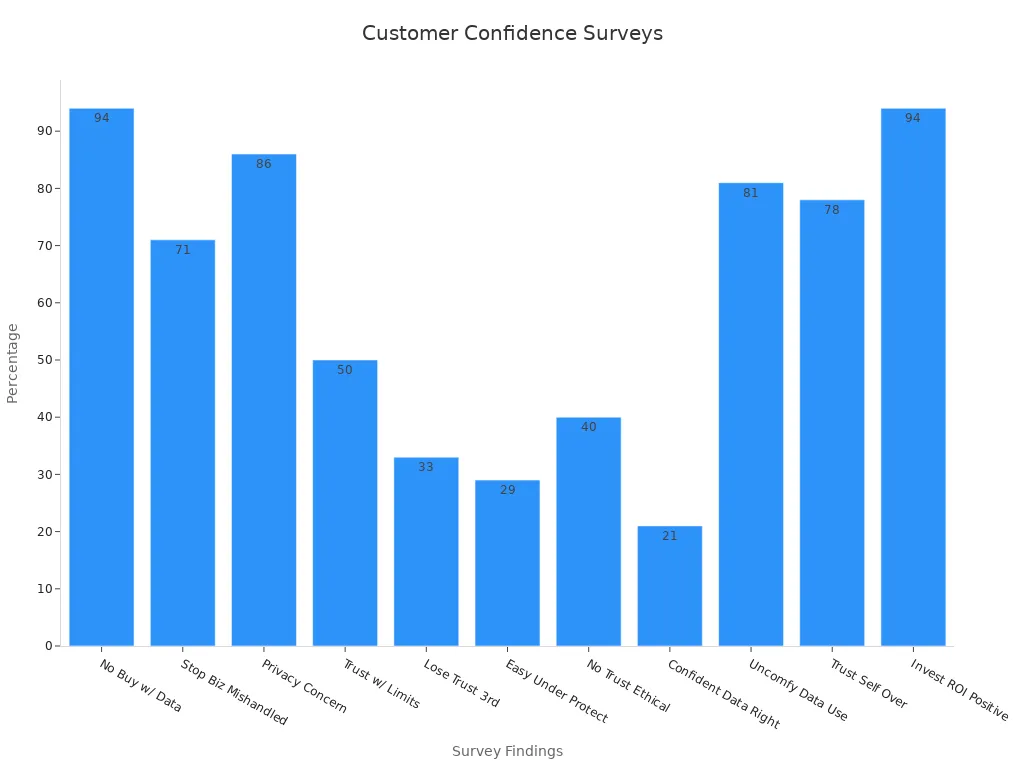
Companies that communicate data practices clearly are 30% more likely to gain customer trust. Sobot empowers customers by providing transparency and easy-to-use privacy controls. The platform’s secure design and proactive communication help brands earn loyalty and improve cx. When customers trust a brand, they engage more and become advocates for the business.
Human-AI Collaboration

Empowering Agents
Empowering customer support agents transforms the quality of cx and drives operational efficiency. Companies see measurable improvements when they equip agents with advanced tools and autonomy. For example, Cisco’s approach to agent empowerment led to higher customer satisfaction, improved Net Promoter Scores, and reduced complaint volumes. Agents resolve issues faster when they access real-time knowledge management and AI-powered support. Decision trees and feedback tools help agents handle complex problems with confidence.
- Integrate feedback tools into agent workflows for continuous improvement.
- Use AI-powered knowledge management to deliver accurate information quickly.
- Guide agents with decision trees for systematic problem-solving.
- Update tools and processes based on agent and AI insights.
SMB Champions ramp up agents 49% faster and exceed customer satisfaction goals 18.3 times more often than less empowered teams. Providing omnichannel support and a 360-degree customer view enables seamless interactions. Sobot’s platform offers these capabilities, giving agents the resources they need to deliver exceptional service.
Empowered agents feel more satisfied in their roles, which leads to better customer experiences and higher retention rates.
Hybrid Support Models
Hybrid support models blend the strengths of humans and AI to optimize cx. AI-powered support handles routine inquiries, freeing agents to focus on complex or emotional issues. For instance, Bank of America’s virtual assistant Erica manages over 2 million daily interactions, allowing human agents to address high-value tasks. SuperAGI’s hybrid approach reduced resolution times by 40% and increased customer satisfaction by 25%.
Key metrics for hybrid models include:
- First Contact Resolution (FCR) above 70%
- Customer Satisfaction Score (CSAT) of 85% or higher
- Bot deflection rates between 50–70%
- Balanced agent utilization and average handle time
Sobot’s all-in-one contact center supports hybrid models by integrating AI chatbots with human agents. This approach ensures efficient handoffs and unified analytics, optimizing every customer journey. As emerging technologies evolve, hybrid models will continue to set the standard for scalable, high-quality cx.
Employee Experience
Training and Tools
Employee experience shapes the quality of customer service. Harvard Business Review identifies employee experience as the main driver of cx, making investment in training and tools essential. Gallup’s research shows that organizations with high employee engagement outperform others, leading to better customer service outcomes. Real-time assessments, such as interactive quizzes and knowledge checks, help employees learn quickly. Training analytics platforms track engagement and identify knowledge gaps, while feedback surveys measure satisfaction and relevance.
| Evaluation Level | KPIs / Metrics | Measurement Methods | Support for Employee Performance Enhancement |
|---|---|---|---|
| Learning | Acquired knowledge and skills | Pre- and post-training tests, interviews | Confirms training meets learning objectives |
| Behavior | Employee engagement, morale | Observations, reviews, open-ended questions | Shows application of training to daily work |
| Results | Retention, productivity, customer satisfaction | Surveys, interviews, performance data analysis | Links training to tangible business and performance outcomes |
Sobot provides advanced tools that empower employees to deliver excellent service. Its unified workspace and AI-powered knowledge base help agents resolve issues faster and more accurately. These resources support continuous learning and skill development, which directly improve cx.
Culture of Customer-Centricity
A customer-centric organization creates a culture where employees focus on meeting customer needs. Only 38% of U.S. consumers feel employees understand their needs, and 82% want more human interaction. Companies that foster a customer-focused culture see higher customer satisfaction, loyalty, and profitability. Key metrics include Customer Satisfaction Scores, Net Promoter Score, Customer Retention Rate, and Customer Lifetime Value. These metrics show how a customer-centric approach leads to better business outcomes.
- Deliver real-time customer experience training to employees.
- Monitor employee performance using customer satisfaction scores and response times.
- Encourage self-evaluation and continuous improvement.
- Track and analyze customer feedback.
- Celebrate positive feedback to motivate employees.
- Empower employees to make decisions during customer interactions.
- Align internal processes to support excellent service.
Sobot’s solutions help organizations build a customer-centric culture by providing tools for feedback, analytics, and seamless communication. This approach ensures employees stay engaged and focused on delivering outstanding cx.
Data-Driven Decisions
Analytics in CX
Analytics play a vital role in shaping modern cx strategies. Companies use data analytics to understand customer behavior, identify trends, and make informed decisions. For example, organizations analyze customer calls and feedback to pinpoint onboarding pain points. This process leads to improved training and better customer interactions. Segmenting customer data by region allows businesses to tailor offerings, which increases engagement and satisfaction.
Advanced analytics tools, such as natural language processing and machine learning, help uncover hidden patterns in customer interactions. Real-time data processing enables immediate feedback analysis, allowing teams to respond quickly and improve cx. Key performance metrics include Net Promoter Score (NPS), Customer Satisfaction Score (CSAT), and Customer Effort Score (CES). Companies also track conversion rates, cart abandonment, and customer lifetime value to measure the impact of their efforts.
Sobot’s platform integrates data from multiple channels, providing a unified view of customer journeys. The system offers customizable dashboards and real-time reporting, making it easier for teams to monitor essential metrics and drive optimization. By linking cx metrics to business goals, organizations can demonstrate clear ROI and prioritize improvements.
Tip: Regularly review analytics to spot trends and adjust strategies for better outcomes.
Continuous Optimization
Continuous optimization ensures that cx initiatives remain effective and relevant. Leading companies adopt journey-centric approaches, mapping customer journeys to identify key milestones and improvement opportunities. They establish standard processes and governance structures, creating a culture of ongoing change.
A strong listening strategy captures feedback from multiple channels, including chat transcripts and operational data. Teams set journey-level goals tied to business outcomes and track metrics like time to resolution and CSAT. Identifying target customer segments helps tailor experiences and prioritize changes that matter most.
Successful organizations focus on "moments that matter" within the customer journey. They test improvements through small-scale experiments before full rollout. Agile methodologies and cross-functional teams enable rapid response to feedback and support continuous optimization. Sobot supports this process by providing AI-driven insights and automation tools that help businesses iterate and enhance cx over time.
Note: Continuous optimization relies on accurate data analytics, employee empowerment, and leadership commitment to sustain long-term cx excellence.
Adapting to 2025’s customer experience trends is urgent for every business. Companies see higher revenue and loyalty when they use innovation, omnichannel strategies, and AI-driven solutions like Sobot. Research shows:
- 71% of consumers expect personalized interactions, and 84% of companies improving customer experience report increased revenues.
- AI-driven personalization boosts ROI by 25% and doubles engagement.
Sobot’s all-in-one platform helps brands meet these demands. Leaders should review their customer experience management approach, embrace digital transformation, and prioritize customer-centricity to stay ahead. 🚀
FAQ
What is customer experience management and why does it matter in 2025?
Customer experience management means organizing every interaction to improve satisfaction and loyalty. In 2025, 81% of organizations see it as a key differentiator. Companies like Sobot help brands deliver seamless support, which leads to higher revenue and retention. Source
How does AI improve customer experience management?
AI automates routine tasks, provides instant answers, and personalizes support. Sobot’s AI chatbot increases productivity by 70% and reduces costs by up to 50%. Businesses using AI in customer experience management see faster response times and higher customer satisfaction.
What role does omnichannel support play in customer experience management?
Omnichannel support connects chat, voice, email, and social media. Customers switch channels without repeating information. Sobot’s platform unifies these channels, making customer experience management more efficient and consistent. Brands using omnichannel strategies see a 90% boost in retention rates.
How does Sobot ensure data privacy in customer experience management?
Sobot follows strict compliance standards like GDPR. The platform uses data encryption and privacy-by-design features. This approach builds trust and supports secure customer experience management. Over 70% of consumers say they trust brands that protect their data.
Can customer experience management increase sales and loyalty?
Yes. Companies that invest in customer experience management report a 25% increase in ROI and double engagement rates. Sobot’s solutions help brands personalize interactions, leading to higher repurchase rates and stronger loyalty.
Tip: Regularly review your customer experience management strategy to stay ahead of changing customer needs.
See Also
Discover The Leading Cloud Contact Centers For 2025
Best Ten Customer Voice Software Solutions In 2024
2024 Reviews Of The Best Cloud Contact Center Services
